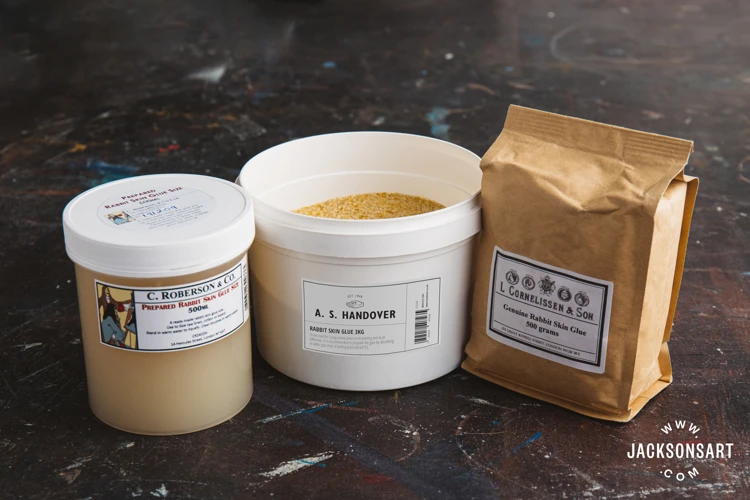Rabbit glue is a time-honored adhesive that has played an essential role in various crafts and art preservation practices. Recognized for its strong bonding capabilities, it is a form of animal glue that has been used since ancient times. Its primary use today remains in fine arts and woodworking, where it is appreciated for its unique properties and revered as part of traditional craftsmanship.
Historical Significance of Rabbit Glue
The history of rabbit glue is intertwined with the evolution of art. This adhesive has been instrumental in the creation and maintenance of masterpieces throughout the centuries. Its application ranged from the canvases of Renaissance artists to the delicate veneers of antique furniture. Understanding its historical context not only provides insight into past practices but also gives depth to its modern usage.
The Composition of Rabbit Glue
Natural Adhesives and Protein Colloid Glue
As a subset of natural adhesives, rabbit glue is a type of protein colloid glue. It is created by prolonged boiling of connective tissues from rabbits, which produces a gelatinous mixture that solidifies upon cooling. This protein-rich substance provides a robust and reversible bond, making it an ideal adhesive for various applications where durability and removability are valued.
Animal Glue vs. Hide Glue
While rabbit glue falls under the broader category of animal glue, it is often compared with hide glue, another traditional adhesive. Although both are derived from animal by-products, they possess distinct characteristics that cater to different needs in the arts and crafts domain.
Differentiating Adhesive Properties
- Setting Time: Rabbit glue generally has a quicker setting time compared to hide glue, facilitating faster work processes.
- Flexibility: Hide glue tends to be more rigid, whereas rabbit glue offers a slightly more flexible bond, which is particularly useful in applications requiring minor adjustments post-adhesion.
- Strength: Both glues provide strong adhesion, but their specific bonding strengths can vary based on the formulation and the materials they are used with.
Applications in Art and Woodworking
Rabbit glue’s versatility extends to multiple domains, but it is most prominently used in art and woodworking. The reasons for its continued popularity are its reliability and the high-quality finish it provides.
Using Rabbit Glue as a Gesso Primer
One of the prominent uses of rabbit glue is as a gesso primer. When preparing a canvas or panel, artists often seek a smooth and stable ground for painting. A mixture of rabbit glue and chalk creates a historically accurate gesso that is still favored by traditionalists for its absorbent and adhesive qualities.
Rabbit Glue in Woodworking Glue Formulations
In woodworking, rabbit glue contributes to the formulation of woodworking glue that is revered for its bond strength and ease of application. Its reversibility is especially valued in the restoration of antique furniture, where non-invasive methods are preferred.
Preparing Rabbit Glue
Ingredients and Proportions
To prepare rabbit glue, one needs the granulated glue itself and water. The ratio of water to glue can vary, but a standard proportion is one part glue to four parts water. This ratio ensures a consistency that is neither too thick nor too runny, which is crucial for effective application.
Step-by-Step Preparation Guide
- Soak the rabbit glue granules in water for several hours until they swell and absorb the water.
- Heat the swollen granules in a double boiler, stirring until they dissolve completely.
- Allow the solution to cool slightly before using it as required.
Preservation Techniques
Given its long-standing use in historical art materials, rabbit glue is not just an adhesive but also an integral part of preservation techniques. Conservators favor it for its reversibility, which is a key criterion in the ethics of conservation and restoration.
Conservation and Restoration Uses
In the realm of conservation and restoration, rabbit glue is employed to repair and maintain items in a way that can be undone, should future restorers wish to intervene. This aspect of its use highlights the importance of selecting materials that respect the integrity and longevity of historical artifacts.
Modern Alternatives and Comparisons
Despite its esteemed place in traditional practices, modern alternatives to rabbit glue have emerged. These contemporary substitutes often aim to mimic the desirable qualities of rabbit glue while providing additional benefits such as increased durability or resistance to environmental factors.
Curious about the various types of adhesives derived from animals? Our articles delve into a range of these sticky substances, each with its unique properties and uses. For instance, if you’re interested in learning about the natural adhesive known as propolis, often referred to as “bee glue,” check out our detailed explanation at what is bee glue. Alternatively, if you’re looking into adhesives used in cosmetics or hair care, you may want to read about what is wig glue. For those interested in a historical perspective on organic glues, our article on what is fish glue offers insight into this collagen-based adhesive. And for a comprehensive understanding of animal glues, don’t miss our upcoming article on “What Is Rabbit Glue,” which will explore the uses and production of this traditional binder.
Transition from Historical Art Materials to Contemporary Substitutes
The transition from historical art materials like rabbit glue to contemporary substitutes is driven by the need for materials that can withstand the test of time and changing environmental conditions. While some purists continue to use rabbit glue for its historical authenticity, many artists and woodworkers have embraced modern adhesives that offer similar adhesive properties without the need for preparation or special storage conditions.
In conclusion, rabbit glue remains a revered component in the world of fine arts and woodworking. Its historic significance, unique composition, and specific applications have cemented its status as a cherished traditional material. While modern alternatives offer convenience and durability, the allure of rabbit glue persists, epitomizing the marriage of art and history in every application.



